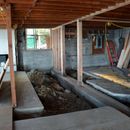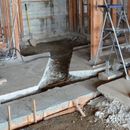How to insulate a new, small basement slab pour within an existing slab
Deep energy retrofit combined with extensive remodel of early 60’s modern architecture home overlooking Puget Sound. Using cameras we found drain pipes under the basement slab were compromised. We took this opportunity to remove the slab in these areas as well as over areas where two bathrooms are being built, one existing and one new for the master bath, to accommodate hydronic radiant heat. The idea is to install hydronic radiant slabs in these two areas but we want to isolate them from the surrounding slab as well as from underneath. New foundations drains were installed and no water has appeared in the new excavations in the basement. Even so, we’re reluctant to install the slabs without a waterproof seal between new and old. I’d like some help with the following:
1. Preparation of the ground.
2. Type of insulation (XPS?).
3. Things to be aware of on the hydronic installation (I will be working with a reputable radiant floor company on this).
4. If we should worry about a waterproof seal between the new and old slabs and, if so, what our options might be to create that seal.
5. Other information we should know about this scenario.
In addition, what approach (vapor barrier, insulation, subfloor, etc) should we take for installing 2′ x 2′ tile and carpet on the old slab?
We’re installing a Daikin Altherma system with radiant floors upstairs and hyronic fan coil units and radiant panels downstairs. Since we have a hydronic source, we though we’d use it to heat the floors of the two downstairs bathrooms.
Thanks,
Greg
GBA Detail Library
A collection of one thousand construction details organized by climate and house part











Replies
Greg,
There are more issues here than can be easily dealt with in this forum.
However, if you really intend to heat small portions of the slab and isolate those hot slabs thermally from adjacent cold slabs, you would need to install vertical XPS insulation at the perimeter of all your excavations. Once you do that, I don't think you can make a watertight seal between the old slabs and the new slabs.
Your intended goal is ambitious. The best way to achieve it -- not the cheapest -- would be to demo the entire slab.
If you're expecting a nice toasty floor under your toes from the in-slab hydronic loop you'll almost certainly be disappointed. Tile or concrete floors do not feel warm to the touch at less than 10° or so above ambient and in a well-insulated basement in your climate the loop will seldom be running to achieve this, and almost never during the specific times that you need it. I'd go for fan-coil heating of the bathroom with a nice always-warm-to-the-touch cork floor, or if that's impractical, a big cosy bath rug.
I have not been impressed with any of the radiant floor systems that I have installed, so I have been using Runtal flat panel radiators for 3-4 years now and have had great results. A fan coil is unnecessary because the back of the radiator has convective tubes and the front radiates heat, so you get both methods of heat delivery in one very attractive, easy to repair package. They also make hydronic towel racks!